Effect of Single Loading Time to the Cyclic Ablation of C/C-SiC-ZrC Composite
Abstract
:1. Introduction
2. Experimental Procedure
3. Results and Discussion
3.1. Ablation Characteristics
3.2. Ablation Mechanism
4. Conclusions
Author Contributions
Funding
Institutional Review Board Statement
Informed Consent Statement
Data Availability Statement
Conflicts of Interest
References
- Zhao, Z.; Li, K.; Kou, G.; Liu, T.; Li, W. Mechanical properties and ablation behavior of C/C-ZrC and C/C-ZrC-SiC composites prepared by precursor infiltration and pyrolysis combined with chemical vapor infiltration. Ceram. Int. 2018, 44, 23191–23201. [Google Scholar] [CrossRef]
- Li, Z.; Li, H.; Zhang, S.; Li, W.; Wang, J. Microstructures and ablation properties of C/C−SiC−ZrC composites prepared using C/C skeletons with various densities. Ceram. Int. 2013, 39, 8173–8181. [Google Scholar] [CrossRef]
- Tian, T.; Sun, W.; Xiong, X.; Zhang, H.; Chu, Y. A novel optimized two-step method for preparing the Z-pin-like rods to improve their effect on the ablation resistance of C/C-ZrC-SiC. J. Eur. Ceram. Soc. 2022, 42, 5249–5261. [Google Scholar] [CrossRef]
- Tang, Z.X.; Yi, M.Z.; Yin, H.; Du, Y.; Wu, H.; Peng, K. Ablation behavior of a C/C-ZrC-SiC composite based on high-solid-loading slurry impregnation under oxyacetylene. J. Eur. Ceram. Soc. 2022, 39, 4748–4758. [Google Scholar] [CrossRef]
- Zeng, C.; Zhang, M.; He, H.; Wang, X.; Tong, K.; Wang, Y.; Xu, P.; Zheng, L.; Zeng, G.; Su, Z.; et al. The effect of carbon source addition order during sol-gel process on the properties of C/C–ZrC–SiC composites. Ceram. Int. 2021, 47, 35366–35377. [Google Scholar] [CrossRef]
- Ouyang, H.; Zhang, Y.; Li, C.; Li, G.; Huang, J.; Li, H. Effects of ZrC/SiC ratios on mechanical and ablation behavior of C/C–ZrC–SiC composites prepared by carbothermal reaction of hydrothermal co-deposited oxides. Corros. Sci. 2020, 163, 108239. [Google Scholar] [CrossRef]
- He, Q.; Li, H.; Yin, X.; Wang, C.; Lu, J. Microstructure, mechanical and anti-ablation properties of SiCnw/PyC core-shell networks reinforced C/C–ZrC–SiC composites fabricated by a multistep method of chemical liquid-vapor deposition. Ceram. Int. 2019, 45, 20414–20426. [Google Scholar] [CrossRef]
- He, Q.C.; Li, H.J.; Tian, Q.; Lu, J.; Wang, Y. Influence of carbon preform density on the microstructure and ablation resistance of CLVD-C/C-ZrC-SiC composites. Corros. Sci. 2021, 190, 109648. [Google Scholar] [CrossRef]
- Peng, Z.; Sun, W.; Xiong, X.; Zhan, Z.; Li, J. Comparative insights into C/C–ZrC–SiC composites with different substrate carbon on microstructures, mechanical properties, and ablation behaviors. J. Mater. Res. Technol. 2021, 14, 662–676. [Google Scholar] [CrossRef]
- Li, J.; Yang, X.; Su, Z.-A.; Xue, L.; Zhong, P.; Li, S.-P.; Huang, Q.-Z.; Liu, H.-W. Effect of ZrC–SiC content on microstructure and ablation properties of C/C composites. Trans. Nonferr. Metal. Soc. 2016, 26, 2653–2664. [Google Scholar] [CrossRef]
- Yan, C.; Liu, R.; Zhang, C.; Cao, Y. Ablation and mechanical properties of 3D braided C/ZrC–SiC composites with various SiC/ZrC ratios. Ceram. Int. 2016, 42, 19019–19026. [Google Scholar] [CrossRef]
- Peng, Z.; Sun, W.; Xiong, X.; Zhang, H.; Zhan, Z. Surface modification and ablation behaviors of nitrogen-doped C/C-ZrC-SiC composites via hot isostatic pressing. Corros. Sci. 2021, 192, 109844. [Google Scholar] [CrossRef]
- Murthy, T.S.R.C.; Duan, M.Y.; Zou, J.; Wade, J.; Venkatachalam, V.; Baker, B.; Nayebossadri, S.; Binner, J. Ablation behaviour of Cf–ZrC-SiC with and without rare earth metal oxide dopants. Open Ceram. 2022, 10, 100270. [Google Scholar]
- He, Q.C.; Li, H.J.; Yin, X.M.; Lu, J. Effects of PyC shell thickness on the microstructure, ablation resistance of SiCnws/PyC-C/C-ZrC-SiC composites. J. Mater. Sci. Technol. 2021, 71, 55–66. [Google Scholar] [CrossRef]
- Wu, X.W.; Su, Z.A.; Huang, Q.Z.; Tong, K.; Xie, X.; Zeng, C. Effect of ZrC particle distribution on the ablation resistance of C/C-SiC-ZrC composites fabricated using precursor infiltration pyrolysis. Ceram. Int. 2020, 46, 16062–16067. [Google Scholar] [CrossRef]
- Jia, Y.J.; Yao, X.Y.; Sun, J.J. Effect of ZrC particle size on the ablation resistance of C/C-ZrC-SiC composites. Mater. Design 2017, 129, 15–25. [Google Scholar] [CrossRef]
- Tian, T.; Sun, W.; Qing, X.; Chu, Y.; Chen, H.; Liu, Y.; Xiong, X.; Zhang, H. Effect of surface structure unit of 3D needled carbon fiber preform on the ablation improvement of “Z-pins like” V0.9-Si0.1 rod for C/C–ZrC–SiC. Ceram. Int. 2021, 47, 33463–33475. [Google Scholar] [CrossRef]
- Zhao, R.D.; Hu, C.L.; Wang, Y.H.; Pang, S.; Li, J.; Tang, S.; Cheng, H.-M. Construction of sandwich-structured C/C-SiC and C/C-SiC-ZrC composites with good mechanical and anti-ablation properties. J. Eur. Ceram. Soc. 2022, 42, 1219–1226. [Google Scholar] [CrossRef]
- Tian, T.; Sun, W.; Qing, X.; Xiong, X.; Zhang, H.; Chu, Y.; Chen, Z.; Zeng, Y. Intelligent cooling structure design of "Z-pins like" silicon rods to enhance the ablation resistance of C/C-ZrC-SiC composites above 2500 °C. J. Eur. Ceram. Soc. 2020, 40, 3875–3886. [Google Scholar] [CrossRef]
- Feng, T.; Shi, X.H.; Hou, W.B.; Tong, M.; Li, H.; Lin, H.; Wen, S. The ablation and mechanical behaviors of C/(SiC-ZrC)n multi-layer structure matrix composites by chemical vapor infiltration. J. Eur. Ceram. Soc. 2022, 42, 4133–4143. [Google Scholar] [CrossRef]
- Yao, J.J.; Pang, S.Y.; Hu, C.L.; Li, J.; Tang, S.; Cheng, H.-M. Mechanical, oxidation and ablation properties of C/(C-SiC)CVI-(ZrC-SiC)PIP composites. Corros. Sci. 2020, 162, 108200. [Google Scholar] [CrossRef]
- Ma, C.H.; Guo, L.J.; Li, H.J.; Tan, W.; Duan, T.; Liu, N.; Zhang, M. Effects of high-temperature annealing on the microstructure and properties of C/SiC–ZrC composites. Mater. Design 2016, 90, 373–378. [Google Scholar] [CrossRef]
- Gao, Y.; Zha, B.L.; Wang, J.J.; Sun, Z.-S.; Zhang, Z.-F.; Shi, Y.-A. Ablation mechanism of C/C–SiC and C/C–SiC–ZrC composites in hypersonic oxygen-enriched environment. Ceram. Int. 2022, 48, 22985–22993. [Google Scholar] [CrossRef]
- Liu, R.; Liu, X.; Wang, Y.; Miao, H.; Song, C.; Qi, G.; Wan, F. Laser ablation behavior and mechanism of Cf/SiC–ZrC ultra-high temperature ceramic matrix composite prepared by PIP method. Ceram. Int. 2021, 47, 23610–23619. [Google Scholar] [CrossRef]
- Wang, S.L.; Li, H.; Ren, M.S.; Zuo, Y.; Yang, M.; Zhang, J.; Sun, J. Microstructure and ablation mechanism of C/C-ZrC-SiC composites in a plasma flame. Ceram. Int. 2017, 43, 10661–10667. [Google Scholar] [CrossRef]
- Feng, W.; Han, Q.X.; Liu, L.; Chen, J.; Yao, X.; Yao, X.; Tian, Y.; Shi, H. Effect of surface air cooling on the high frequent cyclic ablation of C/C-SiC-ZrB2-ZrC composite under ms-scale single loading. Vacuum 2022, 203, 111274. [Google Scholar] [CrossRef]
- Zhang, J.; Zhang, Y.; Zhang, T.; Chen, R.; Zhu, X. Cyclic ablation behavior and microstructure evolution of multi-layer coating on C/C composites under oxyacetylene torch. Ceram. Int. 2022, 48, 21750–21757. [Google Scholar] [CrossRef]
- Hu, D.; Fu, Q.G.; Tong, M.D.; Li, X. Multiple cyclic ablation behaviors of multilayer ZrC-TaC coating with ZrC-SiC interface layer. Corros. Sci. 2022, 200, 110215. [Google Scholar] [CrossRef]
- Xie, J.; Li, K.Z.; Li, H.J.; Fu, Q.; Liu, L. Cyclic ablation behavior of C/C-ZrC-SiC composites under oxyacetylene torch. Ceram. Int. 2014, 14, 5165–5171. [Google Scholar] [CrossRef]
- Hu, C.L.; Pang, S.Y.; Tang, S.F.; Wang, S.; Huang, H.; Cheng, H.-M. Ablation and mechanical behavior of a sandwich-structured composite with an inner layer of Cf/SiC between two outer layers of Cf/SiC-ZrB2-ZrC. Corros. Sci. 2014, 80, 154–163. [Google Scholar] [CrossRef]
- Liu, L.; Li, H.J.; Feng, W.; Shi, X.; Wu, H.; Zhu, J. Effect of surface ablation products on the ablation resistance of C/C-SiC composites under oxyacetylene torch. Corros. Sci. 2013, 67, 60–66. [Google Scholar] [CrossRef]
- Zhao, Z.G.; Li, K.Z.; Li, W.; Zhang, L. Cyclic ablation behavior of C/C-ZrC-SiC-ZrB2 composites under oxyacetylene torch with two heat fluxes at the temperatures above 2000 °C. Corros. Sci. 2021, 181, 109202. [Google Scholar] [CrossRef]
- Li, P.; Jin, X.C.; Hou, C.; Wang, X.; Yuan, M.; Fan, X. Cyclic ablation behaviors of ZrB2-SiC composites sintered with nano-sized particles. Adv. Eng. Mater. 2018, 20, 1800551. [Google Scholar] [CrossRef]
- Liu, L.; Li, B.Y.; Feng, W.; Tang, C.; Zhang, J.; Yao, X.; Yang, Z.; Guo, Y.; Wang, P.; Zhang, Y. Effect of loading spectrum with different single pulsing time on the cyclic ablation of C/C-SiC-ZrB2-ZrC composites in plasma. Corros. Sci. 2021, 192, 109817. [Google Scholar] [CrossRef]
- Inoue, R.; Arai, Y.; Kubota, K.; Kogo, Y.; Goto, K. Initial oxidation behaviors of ZrB2-SiC-ZrC ternary composites above above 2000 °C. J. Alloys Compd. 2018, 731, 310–317. [Google Scholar] [CrossRef]
- Kubota, K.; Tanaka, H.; Arai, Y.; Inoue, R.; Kogo, Y.; Goto, K. Oxidation behavior of ZrB2-SiC-ZrC at 1700 °C. J. Eur. Ceram. Soc. 2017, 37, 1187–1194. [Google Scholar] [CrossRef]
- Jia, Y.; Chen, S.A.; Li, Y.; Wang, S.; Hu, H. High-temperature mechanical properties and microstructure of C/C-ZrC-SiC-ZrB2 composites prepared by a joint process of precursor infiltration and pyrolysis and slurry infiltration. J. Alloys Compd. 2019, 811, 151953. [Google Scholar] [CrossRef]
- Xu, X.T.; Pan, X.H.; Niu, Y.R.; Li, H.; Ni, D.; Huang, S.; Zhong, X.; Zheng, X.; Sun, J. Difference evaluation on ablation behavior of ZrC-based and ZrB2-based UHTCs coatings. Corros. Sci. 2021, 180, 109181. [Google Scholar] [CrossRef]
- Feng, B.; Li, H.J.; Zhang, Y.L.; Liu, L.; Yan, M. Effect of SiC/ZrC ratio on the mechanical and ablation properties of C/C–SiC–ZrC composites. Corros. Sci. 2014, 82, 27–35. [Google Scholar] [CrossRef]
- Xu, Y.L.; Sun, W.; Xiong, X.; Peng, Z.; Chen, Y.; Hao, Z. Microstructure and properties of ZrC-SiC multi-phase coatings prepared by thermal evaporation deposition and an in-situ reaction method. Surf. Coat. Technol. 2018, 349, 797–806. [Google Scholar] [CrossRef]
- Zhao, Z.G.; Li, K.Z.; Li, W. Ablation behavior of ZrC-SiC-ZrB2 and ZrC-SiC inhibited carbon/carbon composites components under ultrahigh temperature conditions. Corros. Sci. 2021, 189, 109598. [Google Scholar] [CrossRef]
- Zhang, M.Y.; Li, K.Z.; Shi, X.H.; Tan, W.-L. Effects of SiC interphase on the mechanical and ablation properties of C/C-ZrC-ZrB2-SiC composites prepared by precursor infltration and pyrolysis. Mater. Design 2017, 122, 322–329. [Google Scholar] [CrossRef]

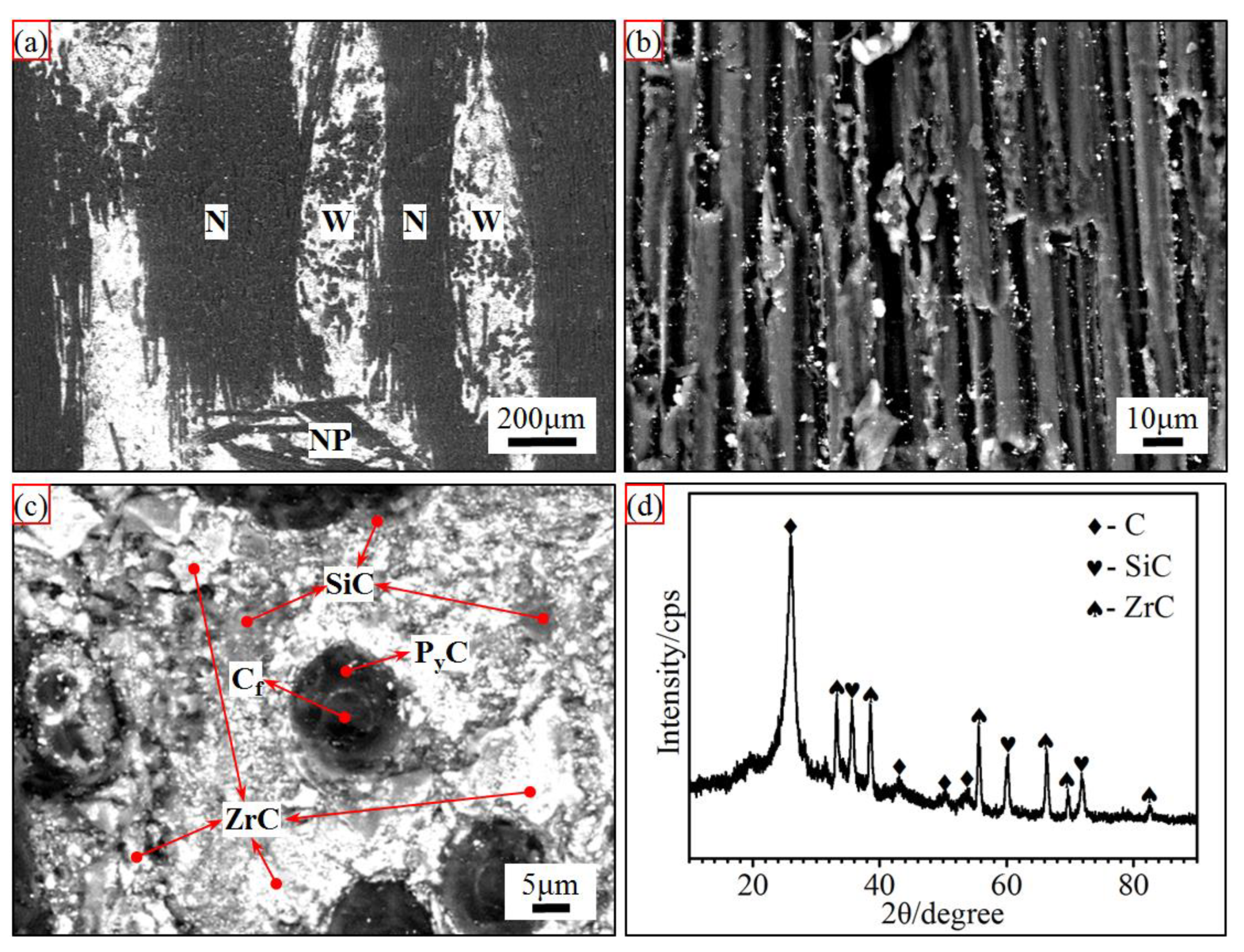

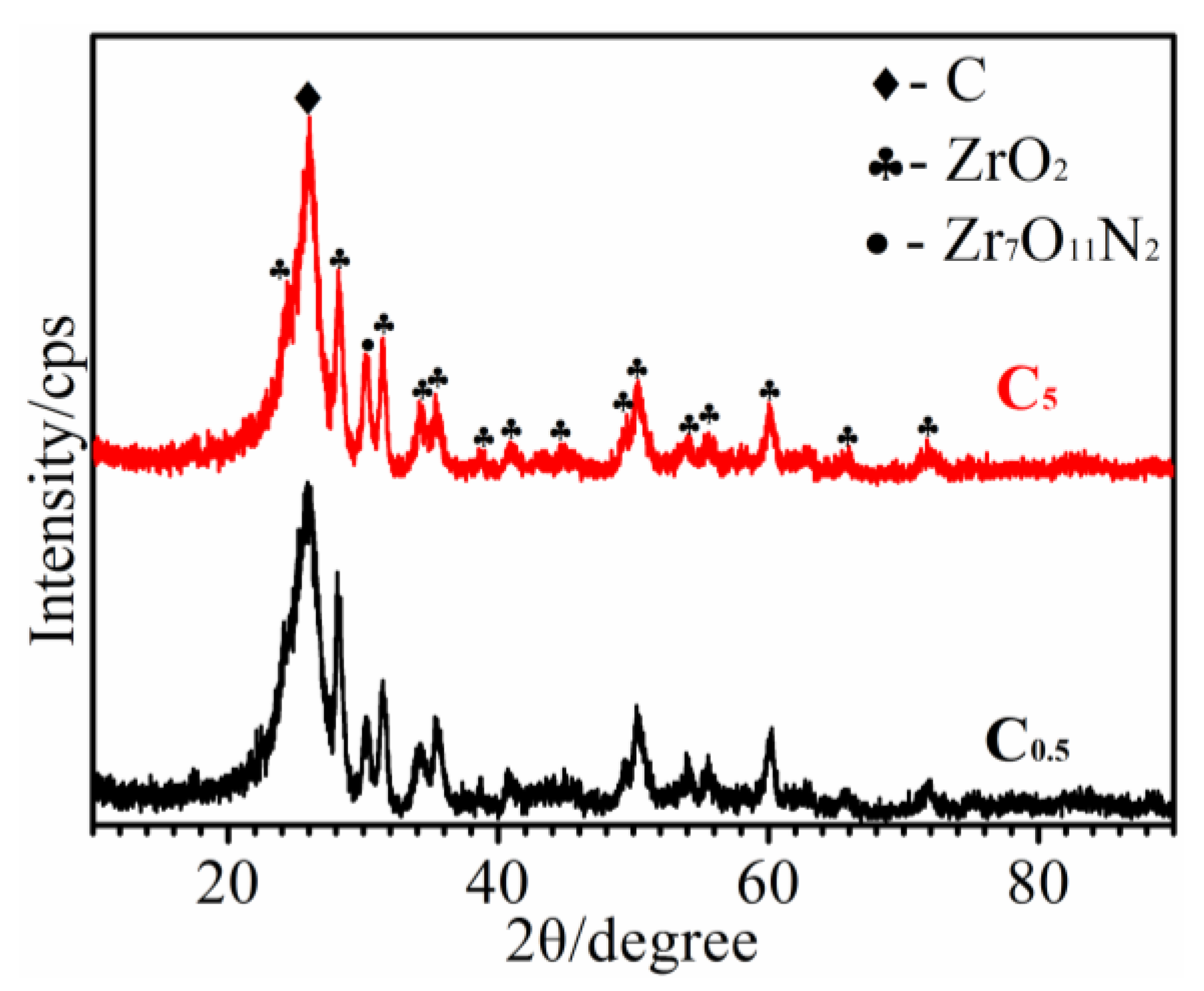

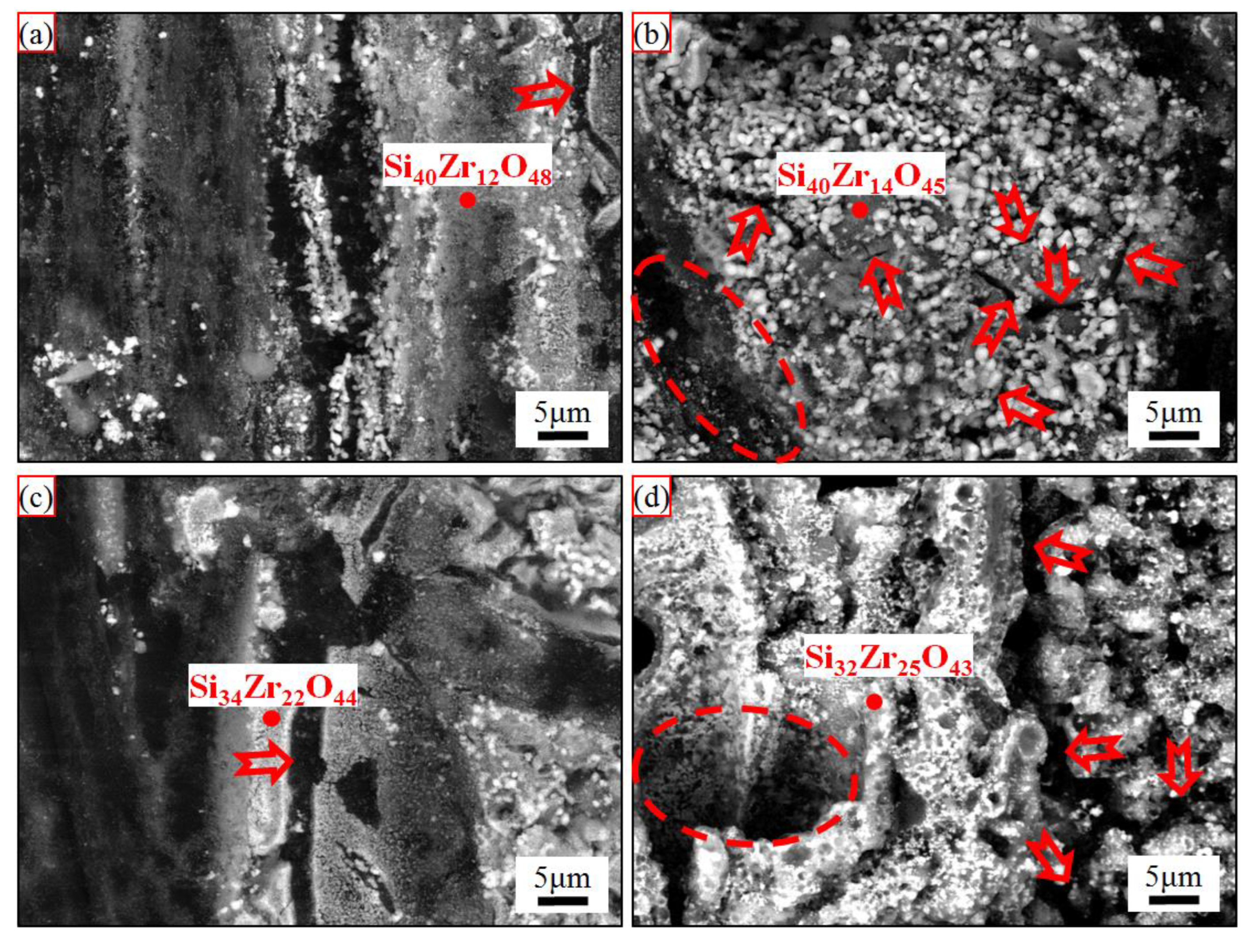
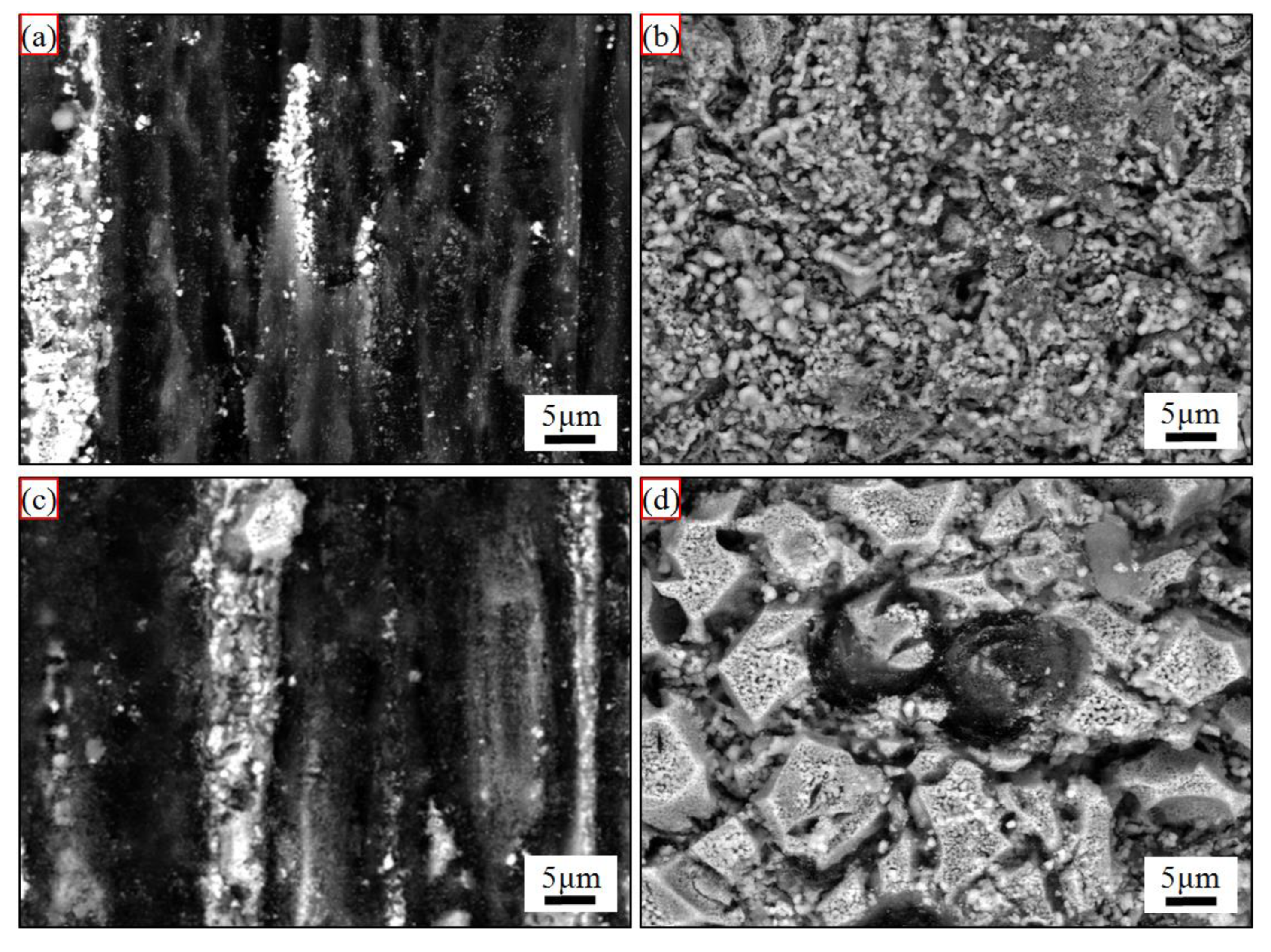
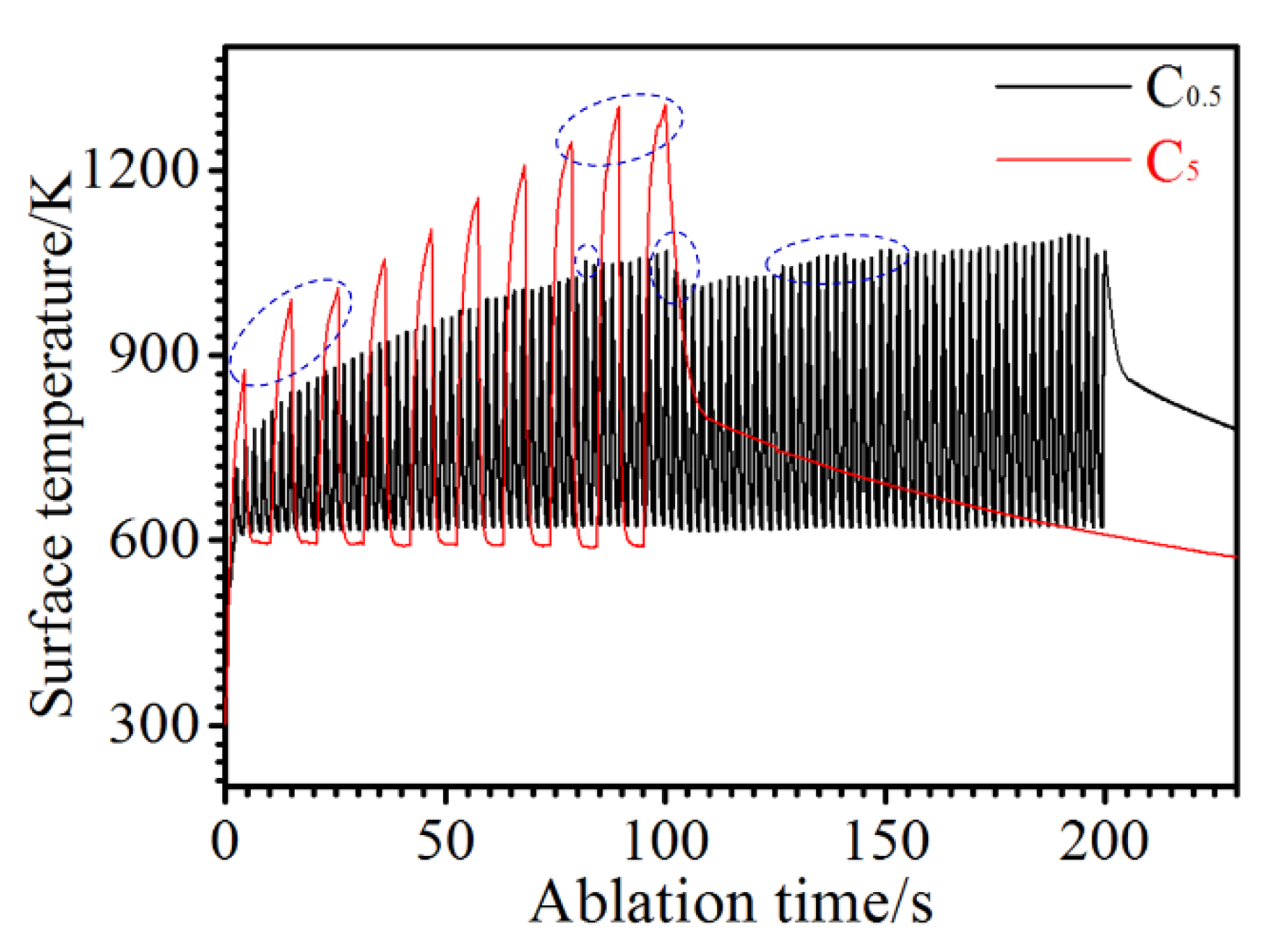
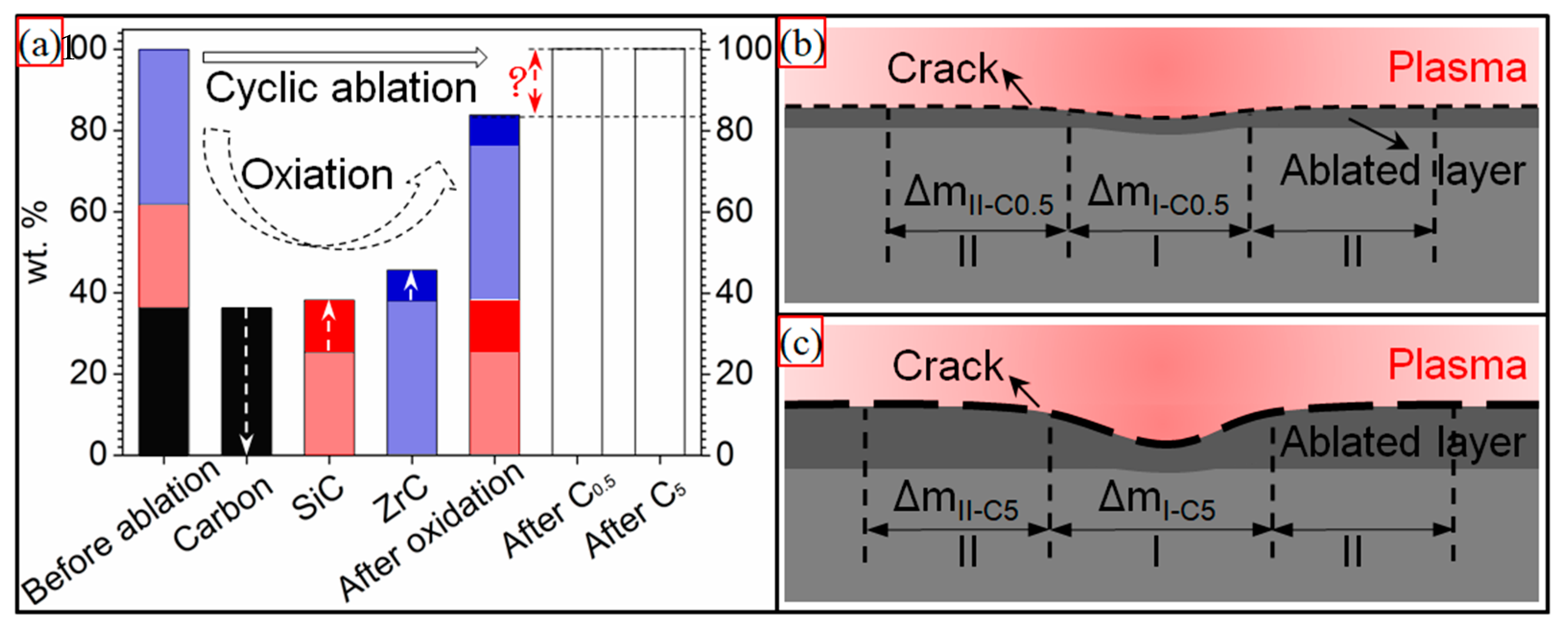
Publisher’s Note: MDPI stays neutral with regard to jurisdictional claims in published maps and institutional affiliations. |
© 2022 by the authors. Licensee MDPI, Basel, Switzerland. This article is an open access article distributed under the terms and conditions of the Creative Commons Attribution (CC BY) license (https://creativecommons.org/licenses/by/4.0/).
Share and Cite
Feng, W.; Wang, X.; Tian, Y.; Liu, L.; Li, B. Effect of Single Loading Time to the Cyclic Ablation of C/C-SiC-ZrC Composite. Materials 2022, 15, 7027. https://doi.org/10.3390/ma15197027
Feng W, Wang X, Tian Y, Liu L, Li B. Effect of Single Loading Time to the Cyclic Ablation of C/C-SiC-ZrC Composite. Materials. 2022; 15(19):7027. https://doi.org/10.3390/ma15197027
Chicago/Turabian StyleFeng, Wei, Xinyu Wang, Yunlong Tian, Lei Liu, and Boyan Li. 2022. "Effect of Single Loading Time to the Cyclic Ablation of C/C-SiC-ZrC Composite" Materials 15, no. 19: 7027. https://doi.org/10.3390/ma15197027




